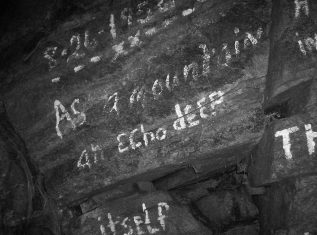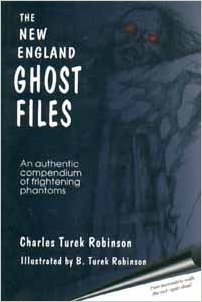Some places are home to solitary ghosts, lone figures trapped in time who appear dark against the landscape, telling everyone they do not belong. They are not the scary monsters of out nightmares, but tragic figures, often replaying the moment of their deaths and inspiring empathy instead of fear. They are unexplained, but more than that, they are physical moments of history, reminding us what once was and forcing us to remember a past we try to put behind us.
The Freetown State Forest is bursting at the seams with violent places. There are monsters in this section and bodies found in that, but one location keeps the spirit of a noble diplomat turned warrior. Philip, the last leader of the Wampanoags before the dismantling of his nation, once stood high on the rocks there, watching his land slowly slip away. He now returns, unable to let go and still hoping he can somehow keep his people together.
 The most recognizable feature within the forest, and perhaps the most noticeable natural landmark in Massachusetts, might be the rock formation on Old Joshua’s Mountain. Named after the first permanent settler in the area, Joshua Tisdale, it is the state’s own Old Man in the Mountain. Most people in the area know it by its more descriptive name, Profile Rock, and the people who visit there know the man immortalized in the stone attracts spirits the way he once drew in his people.
The most recognizable feature within the forest, and perhaps the most noticeable natural landmark in Massachusetts, might be the rock formation on Old Joshua’s Mountain. Named after the first permanent settler in the area, Joshua Tisdale, it is the state’s own Old Man in the Mountain. Most people in the area know it by its more descriptive name, Profile Rock, and the people who visit there know the man immortalized in the stone attracts spirits the way he once drew in his people.
Although formed by natural means, people have felt for centuries the perfect profile on Joshua’s Mountain is that of Massasoit, Wampanoag sachem during the early days of English settlement and father to Alexander and Philip. The fifty foot high rock is surrounded by woods on all sides, with paths cut out mostly by foot traffic. The entrance off Slab Bridge Road is accessible to the public, and the park rangers identify it as one of the most popular spots in the area. The rock is not physically within the woods, but the property is now considered part of the state forest.
Once inside the park, visitors notice the profile as they turn up the rock trail, set off on both sides by medium sized, irregular stones. Bikes and motorcycles often stop off to view the mountain, and from that distance the face still appears noble, solid and strong and still watching over the forest.
Despite attempts to keep it clean and restore its beauty, it is still a meeting place for the youth of the town, a place to get drunk and let loose, and the many niches constituting the sides of the mountain make it more attractive to people doing no good. Unlike the Assonet Ledge, a good pair of shoes will allow you to climb from the bottom up to the head of Massasoit, and people have been known to climb halfway up to break off pieces.
History does not tell when Massasoit became connected to Profile Rock, but it is known the mountain was considered sacred long before the chief came into power. For generations preceding his birth, the Wampanoag met there to discuss tribal issues and to protect themselves against their enemies. It was a vital part of their culture, easily accessible and high enough to see much of the surrounding land. It provided an excellent defense, but there was a positive energy they felt and were attracted to.
Looking back, Massasoit might have felt like a savior to many within his tribe. He kept the people together in the face of disease, tribal warfare and the English settlers. It is understandable they would associate the stone with him, but it was this recognition that may have trapped his son, Philip, to remain at Profile Rock. After the death of his father Philip was forced to deal with intensifying problems with the English, other tribes and his own people. He often came to the mountain to seek guidance. During the war it is said he went to the rock to mediate and meet with his war general, Anawan. No doubt he felt some connection to the place many claimed looked like his father, but he may have also used it to remind the people of his bloodline.
 Massasoit had formed a tentative alliance with the English of Plymouth Colony, brokering the peace for decades before his death. He was known as a wise man and a resource, even in the next life, for policy and strategy and would have made a good counselor, even in death. This might account for the reports today of a man sitting in a praying position on the rock. Perhaps the intensity of Philip’s prayers there imprinted themselves and we see the fallen sachem replaying his futile attempt to save his people from massacre.
Massasoit had formed a tentative alliance with the English of Plymouth Colony, brokering the peace for decades before his death. He was known as a wise man and a resource, even in the next life, for policy and strategy and would have made a good counselor, even in death. This might account for the reports today of a man sitting in a praying position on the rock. Perhaps the intensity of Philip’s prayers there imprinted themselves and we see the fallen sachem replaying his futile attempt to save his people from massacre.
Patrick knew of Profile Rock from an early age. Aside from seeing it on the patches of the police in town, his father would bring him to the mountain when he went to paint landscapes of it. His father would sit for hours, trying to capture the perfect emotion of the place, and Patrick would play with the rocks and try to climb the trees.
“My father was not an artist. He had taken some classes before, but he was a cook. Not at all what you would think of as a painter, but he loved that place.” Patrick says his father would talk about being drawn in by the stone, but he could never communicate why. “He felt something there. He painted other things, but he always went back to Profile Rock. I don’t think he ever got it right. He didn’t know what he felt, he just felt it.”
It meant nothing to Patrick to climb the face of the stone. He had done it for as long as he could remember. In late 2001 the climb felt different.
“I think it was the first time I knew what my father felt. All those times with him and I always used the place as a playground. That day though, I think I felt what he was trying to say with those paintings.”
As he made it way up the rock, carefully placing each foot as he went, He felt the air change around him. It became very warm, almost humid, and he found it hard to breath. He looked up to see someone looking down at him. He said the man had dark skin and no hair. The man extended his arm as if to help Patrick up, but when Patrick looked down to make sure his feet were secure, the man vanished.
“I don’t know what I saw, but the whole thing seemed wrong. Well, not wrong as much as out of place. I never felt threatened, but I knew I had seen a ghost.
Rich saw Philip one afternoon while walking his dog back in 1987. He lived nearby and would take Jingle across the street and into the woods. He approached the rock, all the time looking at the profile. A figure slowly appeared, faint at first and then becoming solid. The man was sitting on the top and stood, extending his hands and then bringing them back to his chest. He sat back down and slowly faded away.

“Jingle saw him too. He can’t tell his story, but I know he saw something. He’s always moving his head side to side and pulling me forward. I saw that Indian and he [the dog] stopped and just stared at the guy.”
Most of the sighting follow the same pattern, and the experience leaves the observer with a profound sense of sadness. They never feel threatened, but they feel they have somehow touched Philip’s grief.
It is said Philip spent the night before his death at Profile Rock, maybe even knowing his fate. After early successes in hit and run battles, the Wampanoag were feeling the momentum of the war shift. Philip must have seen this himself, and it is almost certain he knew he would not live much longer if the English continued to win the war. If it was not the next day, eventually he would fall, and the realization of this might have been enough mark the rock with his anxiety.
The story of the hauntings may be the story of two soldiers and their final meeting with each other. It is also said he had a meeting with Anawan right before this, and it might be this meeting connecting the two allies over the centuries.
After Philip’s death, Anawan was left to continue fighting, and shortly after he saw no other solution than surrender. He officially submitted to Captain Benjamin Church in Rehoboth, Massachusetts, and was taken prisoner by the English. Although he and his troops were promised amnesty, Anawan was executed upon his arrival in Plymouth. It was the final betrayal in a war that prided itself on backstabbing and atrocities.
The area of Rehoboth where he surrendered became known as Anawan Rock, and has a rich history of folklore and hauntings attached to it. According to Charles Turek Robinson, author of The New England Ghost Files, the site has been the subject of rumors almost since Anawan’s death. Some residents report seeing lights at night in the swamps near the rock. Chanting and voices have been heard, the most disturbing of which seemed to be saying, “Stand and fight,” in an Algonquian language. A fire was also seen burning on the rock and then mysteriously disappearing.
After the publication of the book in 1994, people began traveling to Anawan Rock to see the ghosts for themselves. Local teens often hung around as well, getting drunk and hiding in trees, waiting for the curious to come and then giving them the scare of their lives. Some have come forward with more evidence of activity, but it becomes difficult to sift through the stories once a site is known and well traveled to. Often the lore built up around a spot affects the people looking for ghosts. They see lights because they have been told they should. Pictures get over analyzed, and any speck of dust becomes the ancient warrior.
There have been other reports from Anawan Rock which seem genuine and truthful. They mostly involve lights and fires, although a few have heard the chanting and drums Robinson describes. One of the more odd reports involves a teenager who hid himself in the woods to scare people on Halloween back in 1998. While waiting for people to show up, he and his friends were driven out of the woods by a large, red ball of light about the size and shape of a man, which produced an intense heat. Many of the same kinds of reports come from Profile Rock. It does seem the two souls are connected, looking at each other from two battlefields of the war, perhaps trying to warn the other of his fate.
While the anxiety, betrayal and death both suffered is more than enough to explain any ghost at their rocks, there might be another reason their spirits cannot find rest. It may be this connection that explains the curse which continues to plague both towns.
In another book, True New England Mysteries, Ghosts, Crimes and Oddities, Charles Robinson tells the tale of the Wampanoag wampum belt. The belt, a collection of woven beads telling the history of the people, disappeared after the war. The belt stands as the old true history of the Wampanoag, untouched by the Bible or Puritan influence, and its vanishing is symbolic of the Native American of old in New England. Robinson tells how the belt was passed to Anawan and then taken into custody when he was arrested. It fell into the hands of Governor Winslow from Plymouth who sent it back to England as proof of his victory over the Native Americans and his power in the New World. The king never received the prize.
Attempts have been made to trace the history of the belt after its departure from Rehoboth, but none have succeeded. Robinson puts forth several theories to the fate of the artifact, but none have ever been verified and the belt remains missing, destroyed or forgotten in some depository. The history of the Wampanoag remains lost with it.
It has been said Philip might have relinquished the belt to Anawan during one of his meetings at Profile Rock, causing the loss of the history of a people he had sworn to protect. This grief might also force him to perch on his father’s head, leaning towards Rehoboth, waiting for the return of the relic. Some have even said the curse of Bristol County might have been sparked by the removal of the Wampanoag wampum belt, and its return is the only thing that will bring peace to the spirits. It seems unlikely the belt will ever be returned, so the secrets held by the ghosts in the forest, and at Profile Rock, will remain hidden.
And Philip will also continue to appear at Profile Rock.




